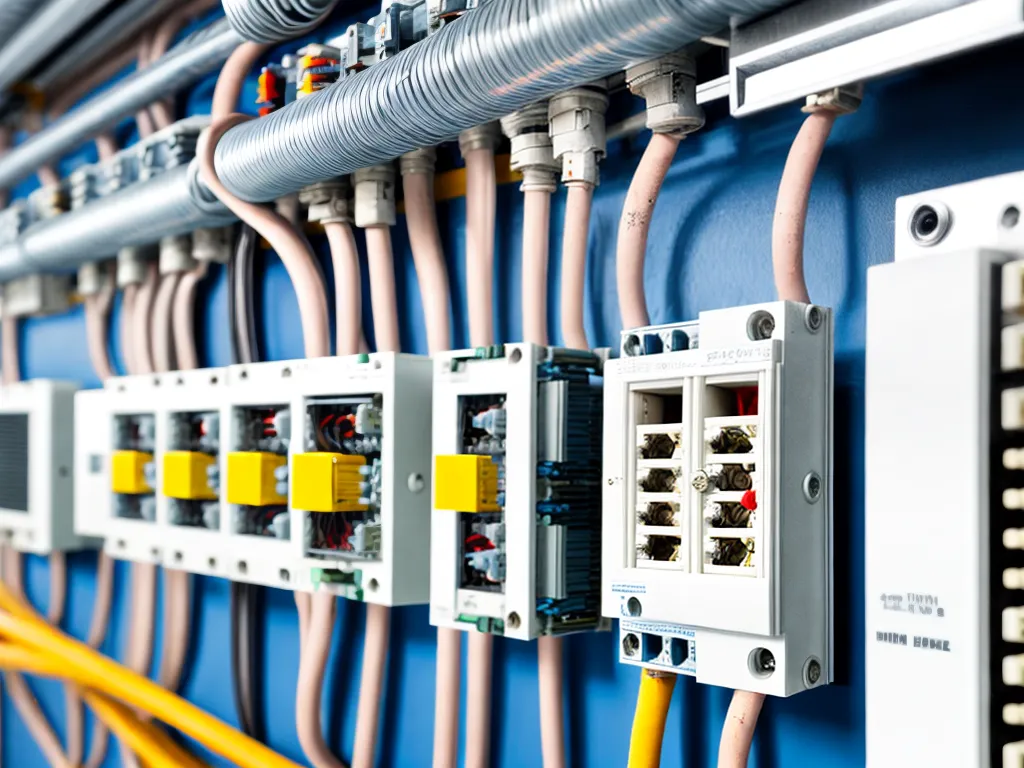
Improving Efficiency in Commercial Electrical Distribution Systems
Conduct an Electrical Load Analysis
The first step I take to improve efficiency is to conduct a thorough electrical load analysis of the commercial facility. This involves reviewing electrical usage data to understand where, when, and how much electricity is being used. I examine usage across different areas, equipment, and times of day. This load analysis provides crucial insights on where efficiency improvements will have the greatest impact.
Some key data I gather and analyze includes:
- Average and peak power demand in kilowatts
- Electrical consumption by area (e.g. HVAC, lighting, equipment)
- Load factor (ratio of average to peak demand)
- Power factor
- Usage trends and schedules
Armed with a detailed understanding of electrical loads, I can target high-usage and inefficient systems for efficiency upgrades.
Implement Lighting Efficiency Measures
Lighting accounts for a major share of electricity use in commercial buildings. I take the following steps to improve the efficiency of lighting systems:
-
Replace outdated lighting - Older lighting like incandescent and CFL bulbs are inefficient. I upgrade to LED lighting which uses at least 75% less energy.
-
Install occupancy sensors - These automatically turn lights on and off based on occupancy. They prevent lights being left on in unoccupied spaces.
-
Use daylighting - Skylights, light tubes, and windows maximize natural light. I install daylighting features and pair them with dimming controls on electric lights.
-
Improve lighting controls - Dimmers, timers and zoning allow better control over lighting use. This reduces over-lighting.
These measures can reduce lighting electricity consumption by 60% or more. The upfront cost is recouped within 2 years through energy savings.
Upgrade HVAC and Mechanical Systems
Heating, ventilation and air conditioning (HVAC) account for around 40% of electricity used in commercial buildings. Some ways I improve HVAC efficiency include:
-
Install variable speed drives - These adjust motor speed based on cooling/heating demand and save up to 50% in power use.
-
Improve ductwork - Sealing leaky ducts improves efficiency by up to 20% by delivering conditioned air where it is needed.
-
Upgrade system controls - Smart thermostats with occupancy sensing reduce runtime while maintaining comfort.
-
Tune-up and replace units - Regular maintenance keeps units running efficiently. Replacing aging units with ENERGY STAR models delivers substantial savings.
-
Improve insulation - This reduces heat loss/gain and the HVAC workload. I ensure insulation meets building codes.
Targeting the HVAC system provides some of the biggest efficiency gains in any commercial facility.
Utilize Efficient Plug Load Devices
Plug load from equipment and appliances accounts for up to 20% of a building's energy use. I implement the following best practices:
- Install advanced power strips to completely shut off standby phantom loads.
- Replace aging plug load devices with ENERGY STAR rated models.
- Use smart plugs to remotely control plug loads and identify savings opportunities.
- Educate occupants on turning off devices when not in use.
- Consolidate and share devices like printers and chargers when possible.
Careful attention to plug loads across the many devices used in a building delivers measurable efficiency gains.
Monitor with an Energy Management System
A key tool I use to continuously improve efficiency is an energy management system (EMS). This centrally monitors real-time energy usage throughout the facility by connecting to smart meters and sensors.
Key features I use in an EMS include:
- Dashboards showing energy usage statistics, trends and alerts.
- Remote control of lighting, HVAC and plug loads.
- Analytics pinpointing problems and savings opportunities.
- Submetering electricity use from specific circuits and equipment.
The data and visibility provided by an EMS enables me to understand patterns of energy use and quickly identify issues like equipment faults and unnecessary consumption. This allows targeted measures that deliver sustained efficiency improvements.
Perform Regular Maintenance and Upgrades
I follow planned preventive maintenance schedules for equipment like HVAC systems and lighting. This routine inspection and servicing keeps equipment operating efficiently. I also continually monitor systems and upgrade components proactively before efficiency declines or breakdowns occur.
For example LED lights are replaced after their rated lifespan to maintain optimum efficiency. HVAC filters are replaced on schedule to maintain airflow.
Doing preventive and proactive maintenance safeguards against energy waste from failing equipment and deterioration over time.
Conclusion
Improving energy efficiency in commercial buildings involves taking a systematic approach. A detailed electrical load analysis provides the starting point to identify opportunities. Lighting systems, HVAC, plug loads and an EMS then provide ways to target major electricity uses with impactful efficiency measures. Continual maintenance and upgrades also prevent backsliding over time. Implementing these best practices allows me to optimize the electrical efficiency of any commercial facility.